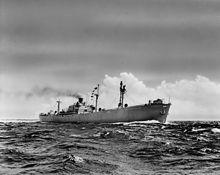
Andrew Benoni Hammond was an American lumberman. He developed the Missoula Mercantile Co. He built the Bitterroot Valley Railroad and the Astoria & Columbia River Railroad. He was president of the Hammond Lumber Co. and the Hammond Steamship Co.
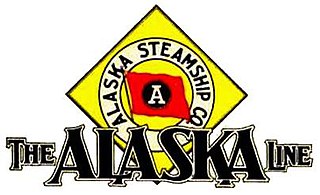
The Alaska Steamship Company was formed on August 3, 1894. While it originally set out to ship passengers and fishing products, the Alaska Steamship Company began shipping mining equipment, dog sleds, and cattle at the outbreak of the Klondike Gold Rush of 1897. The company was purchased by the Alaska Syndicate and merged with the Northwestern Steamship Company in 1909, but retained its name, and the fleet was expanded to 18 ships. During World War II, the government took over the company's ships. When the war ended, the company struggled to compete with the new Alaska Highway for passengers and freight. It discontinued passenger service altogether in 1954 and shut down operations in 1971.
Pacific Far East Line, also called PFEL in short, was a passenger and cargo shipping line founded in 1943 by Thomas E. Cuffe, in San Francisco, California. At the beginning he started by chartering foreign ships to run the lines in tramp trade. Later scheduled cargo services were added to the line. During World War II the South Atlantic steamship line was active with charter shipping with the Maritime Commission and War Shipping Administration.
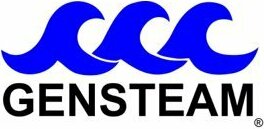
General Steamship Company was founded in 1920 in Houston, Texas, as a Private Company, and now goes by Gensteam since 1996. General Steamship Company has a fleet of cargo ships that operate worldwide. Gensteam has a Gensteam Operations Desk website that tracks all shipping logistics. Gensteam headquarters is now in San Francisco, California. General Steamship Company was part owner of American Pacific Steamship Company in New York state and Los Angeles during and post World War II. American Pacific Steamship Company was founded in 1942 in New York City, and was previously called Los Angeles Tanker Operators Inc. which operated T2 tanker ships. During World War II the General Steamship Company and American Pacific Steamship Company were active with charter shipping with the Maritime Commission and War Shipping Administration.
Shepard Steamship Company of Boston, Massachusetts was founded in 1930 by Otis N Shepard, and H B, Shepard with service from Pacific Coast to Philadelphia, New York City, Albany and Boston. Service was called the Shepard Line Shepard Steamship Company moved to 21 West Street, New York City in 1947. The Shepard Steamship Company's main cargo was lumber products. Otis N Shepard company, Otis Shepard & Co. partnered with George H. Morse in 1868 to form Shepard & Morse Lumber Company of Burlington, Vermont. During World War II the Shepard Steamship Company was active in charter shipping with the Maritime Commission and War Shipping Administration. During wartime, the Shepard Steamship Company operated Victory ships and Liberty shipss. The ship was run by its crew and the US Navy supplied United States Navy Armed Guards to man the deck guns and radio. The most common armament mounted on these merchant ships were the MK II 20mm Oerlikon autocannon and the 3"/50, 4"/50, and 5"/38 deck guns.

Calmar Steamship Company was a proprietary subsidiary of the Bethlehem Steel founded in New York City in 1927. Bethlehem Steel Company founded Calmar Steamship Company and other steamship companies after finding general shipping companies could not meet the company's needs in a timely manner. At the time Bethlehem Steel Company was the second-largest steelmaker in the United States and the world, only behind U.S. Steel. Calmar Steamship Company shipped Bethlehem Steel Company products from the Atlantic coast to the Pacific coast. On the return trip, Calmar Steamship Company would bring lumber products from the Pacific coast to the Atlantic coast. Calmar Steamship Company closed in 1976, as United States steel manufacture declined in the 1960s.
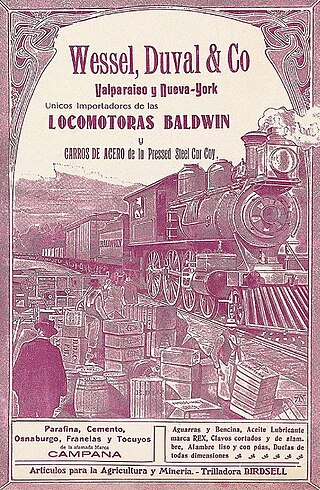
Wessel, Duval & Co. was founded in Boston, Massachusetts in 1825 Augustus Hemenway (1805-1876) as Hemenway & Co.. Augustus Hemenway started the shipping company to move his timber products to markets. Augustus Hemenway had timberland in Maine and started his schooner shipping company to take timber to Eastcoast ports. Later he opened a sugar plant in Cuba, his ships would take lumber to Cuba and bring back sugar. Next, he expanded his timber products to Argentina and other Western South American ports. By 1828 the company expanded to Valparaiso, Chile. Augustus Hemenway married into a Boston merchant family, marrying Mary Tileston (1820-1894) in 1840. In 1865 Héctor Beéche (?-1914) became a partner in the firm and a subsidiary company, Wessel, Duval y Cía, was founded in Chile by Charles P. Hemenway, Augustus's brother. Charles had acted on Augustus' behalf in other matters as needed and became a partner in 1870. T. Quincy Browne became a partner in 1870 also and for a few years the firm was called Hemenway & Browne. In 1875 William Muller joined as a partner, the name returned to Hemenway & Co. Augustus Hemenway died in Cuba in 1876. The partnership continued as Hemenway & Co. till 1885. In 1885 Muller retired and Carlos Wolff joined the partnership, the company name was changed to Hemenway, Beeche and Co.. In 1888 Peter "Perdo" M. Wessel (1851-1821) joined the partnership and the company name was changed to Browne, Beeche and Co.. In 1891 a New York City office was opened on 68 Brad Street, and most key workers moved to New York. The next year the Boston office was closed. In 1896 Wolff retired and in 1897 George L. Duval (1855-1931), W. L. Parker, and q became partners. With the new partners, the company name was changed to Beeche and Co.. In 1905 T. F. Budge and Robert Jaffray became partners. In 1907 the company name was changed to Wessel, Duval & Co. In the 1900s the company moved from sailing ships to steamships and opened a new West Coast Line at 47 Cedar Street, later moved to 1 Broadway. The West Coast Line started regular service from New York City to Valparaiso and Callao, Peru. West Coast Line main cargo was railroad and mining equipment to the expanding business in Chile and Peru, along with general cargo. The Chile rail firm, Ferrocarril del Llano de Maipo in Santiago used Wessel, Duval & Co. to import their railroad equipment in 1890. The return cargo from Chile was nitrate of soda. The West Coast Line chartered steamship as needed and was the US manager and agent for other shipping lines. West Coast Line also shipped UK and US coal for coal ships and to nations. For the West coast of South America both the steamer and sail ships used the starits of Magellan, this changed on August 15, 1914, with the opening of the Panama Canal, some routes began to use the Panama Canal cutting about 10,000 miles off the trip. The outbreak of World War I changed service, some charted ships were requisition by their home country, and the United States Shipping Board, gave some ships to the Line to operate for the War effort. Normal operations did not return till 1924, all post-war work have been completed. In from 1920 to 1932, West Coast Line was the US agent for Compania Sud Americana de Vapores, the South America Steamship Company of Chile. South America Steamship Company had luxury passenger service to and from Chile and New York City, on a fleet of luxury steamers: SS Renaico, SS Aconcagua and SS Teno. During World War II Wessel Duval & Company operated ships to support the war in the Pacific War and European theatre. Wessel, Duval & Co. operated some ships in the support of Korean war in the early 1950s. As ships aged and were retired Wessel, Duval & Co. has moved into media, advertising and marketing.
Northland Transportation Company operated cargo and passenger ships from Seattle to Southeast Alaska starting in 1923. During World War II Northland Transportation Company was active in charter shipping with the Maritime Commission and War Shipping Administration. Northland Transportation Company, proposed a loan from United States Shipping Board to build a ship for Puget Sound-Alaska trade in 1933. In 1934, the company was granted a $350,000 loan to build a new ship. The 1,400 tons passenger ship, was built at Lake Washington Shipyard in Houghton, Washington. Northland Transportation Company Seattle dock and warehouse were at Pier 56, now Ainsworth and Dunn Wharf.

Keystone Shipping Company of Philadelphia, Pennsylvania is a major shipping and transportation company. Keystone Shipping Company operates a fleet of ships for both dry bulk cargo and tankers. Since World War I, the Keystone Shipping Company has been active in the worldwide support of the United States Armed Forces. Keystone Shipping Company is part of the Ready Reserve Fleet program. Keystone Shipping Company was founded by Charles Kurz. Before Keystone Shipping Company, Charles Kurz was a shipping agent, commodities trader, and ship owner. Keystone Shipping Company headquarters is in Bala Cynwyd, Pennsylvania.

Merchants and Miners Transportation Company, often called M&M and Queen of Sea, was a major cargo and passenger shipping company founded in 1852 in Baltimore, Maryland. In 1852 is started with routes from Baltimore and Boston two wooden side wheelers ships. In 1859 M&M added two iron hulled steamers to its fleet. In 1866, post Civil War, M&M added routes to Providence, Rhode Island, Norfolk and Savannah, Georgia. In 1876 M&M purchased the Baltimore & Savannah Steamship Company add routes to Savannah, Jacksonville and Charleston. In 1907 the Winsor Line of Philadelphia's J. S. Winslow & Company of Portland, Maine was purchased, with seven steamships. The Winsor Line was founded in 1884 by J. S. Winslow. The Winsor Line first route was from Norfolk, Virginia to New England ports, supplying West Virginia coal. The Winsor Line sailing ship Addie M. Lawrence took ammunition to Europe during World War I. By World War II M&M had a fleet of 18 ships and add routes to Miami. With the outbreak of World War II the War Shipping Administration requisitioned Merchants and Miners Transportation Company fleet of ships for the war effort.

Blidberg Rothchild Company was a shipping company founded by Allan Blidberg and Sylvester Rothschild in New York City, United States. The shipping company has is start with a previous company Blidberg and Sagen Company founded by Tryggve Sagen and Allan Blidberg. Tryggve Sagen owned a ship in Oslo, Norway before coming to the United States in 1919. Sylvester Rothschild was born in 1896 in Sweden, he was a finance officer in Gothenburg. Rothschild came to America in 1919 and started the shipping company with Sagen. Blidberg and Sagen Company had shipping routes from New York to Scandinavian and Baltic ports. Sagen was president, Blidberg vice president and Sylvester Rothschild was the Secretary for the shipping company. Sylvester Rothschild was from Gothenburg Sweden, were he was the Vice-consul. In the 1930s Tryggve Sagen departed the company and the firm was renamed Blidberg Rothchild Company. The company had offices in Gothenburg and Norway. Blidberg Rothchild Company worked with an affiliated company Eastport Steamship Co of New York. Blidberg Rothchild Company also worked with an affiliated company Bridgeport Steamship Line of New York, a New Haven Railroad company.
Boland and Cornelius Company was a shipping company founded in 1904 by Messrs Boland and Adam E. Cornelius in Buffalo, New York. Adam Edwards Cornelius came up with the idea of having self-unloading ships to save time and money. Adam Edwards Cornelius self-unloading ships changed the way ships were unloading. In 1907 Boland and Cornelius founded the American Steamship Company a subsidiary of Boland and Cornelius Company. American Steamship Company later became the current GATX Corporation. Boland and Cornelius Company flew a white and red flag with B&C in blue.
North Atlantic & Gulf Steamship Company was founded in New York City on February 13, 1932, by George V. Reilly, William M. Stevens, and David H. Jackman. The president of North Atlantic & Gulf Steamship Company in 1932 was Charles Walter Ulsh., North Atlantic & Gulf Steamship Company's treasurer and vice president as Clifton Waller Barrett. Charles Walter Ulsh and Clifton Waller Barrett founded the ship broker firm Ulsh & Barrett. Charles Walter Ulsh invited and patented a skid platform pallet for shipping. His United States patent #US1934389A is used for a stackable and nested skid platform.

Oliver J. Olson & Company was a shipping company founded by Oliver John Olson in 1930 in San Francisco, California. Oliver John Olson started in the lumber trade. Oliver John Olson entered into a lumber partnership with Andrew F. Mahony in San Francisco in 1908. Oliver John Olson was president of the Olson-Mahony Lumber Company. Oliver John Olson was born in San Francisco on January 20, 1872.
Parry Navigation Company was a shipping company founded in 1942 by Alfred Walter Parry Jr. in New York City. Alfred Walter Parry Jr. first career was ship broker with Smith & Terry Inc. in New York City. He was also the office manager of the Interocean Steamship Company of New York in New Orleans. Smith & Terry Inc also were managing agents for the some United States Shipping Board ships. Alfred Walter Parry Jr. father, Alfred Walter Parry, Sr., was an agent for a railroad company. Parry Navigation Company operated ships for the World War II. Alfred Walter Parry Jr. became a Colonel in the United States Army. Parry served with the US Army Transportation Corps in the South Pacific Ocean. Parry Navigation Company expanded the company and opened an office in San Francisco in 1945. Parry Navigation Company stated the Parry Line in 1947 and expanded with route to Galveston, Texas. The Parry Line had routes from the West Coast of the United States to Manila, Shanghai, Hong Kong and North China. Parry was the vice president for the Lykes Brothers Steamship Company for a few years. Parry was awarded the Legion of Merit and World War II Victory Medal for his service in the US Army Transportation Corps. Charles W. Perkes was a manager in Parry Navigation Company. Perkes, before Parry worked for the Dollar Line.
Polarus Steamship Company was founded in 1918, and again in 1923 in New York City by Tikhon Nicholas Agapeyeff (1891–1931). Tikhon N. Agapeyeff's 1918 frim, operated for only about two years. In March 1921, Agapeyeff sold the first Polarus Steamship Company to the C. M. Fetterolf Company for $250,000. The next incorporation in 1923 was a partnership of Agapeyeff, Marcel Levy, and Charles S. Dunaif. Marcel Levy was an attorney and Charles S. Dunaif was an exporter.

Pope & Talbot, Inc. was a lumber company and shipping company founded by Andrew Jackson Pope and Frederic Talbot in 1849 in San Francisco, California. Pope and Talbot came to California in 1849 from East Machias, Maine. Pope & Talbot lumber company was very successful, with the high demand of the 1849 Gold Rush.
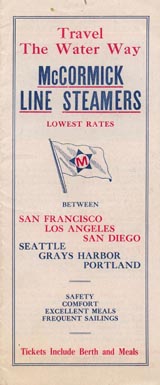
Charles R. McCormick Lumber Company was founded in 1908 by Charles R. McCormick in San Francisco, California. McCormick purchased a mill site in St. Helens, and formed the Helens Mill Company. To feed the mill McCormick's St. Helens Timber Company also purchased 4,000 acres of timber. In 1912 McCormick formed the St. Helens Lumber Company as parent company over Helens Mill Company and the St. Helens Timber Company. In 1912 McCormick expanded the company with a second sawmill, a creosoting plant and shipyard, the St. Helens shipyard. McCormick also expanded into San Diego, California with a railroad ties factory, to supply Santa Fe Railway and the mines of Utah, Arizona, New Mexico, and northern Mexico. At the San Diego site, he built a dock to unload his timbers. With the Great Depression slow down, McCormick closed dock at San Diego in April 1931.

Olympic Steamship Company was founded in Seattle, Washington, on August 22, 1925, by John Ambler, Charles A. Wallace, and William W. Shorthill. The Olympic Steamship Company had routes that served the Pacific Northwest. The Olympic Steamship Company had a fleet of about 4 ships. The Olympic Steamship Company was named after The Olympic Mountains in the state of Washington. John Ambler was an attorney, and Charles A. Wallace previously worked at Fisher Flouring Mills Company. William W. Shorthill was a clerk at The Pacific Steamship Company. After the start of the company, Joseph L. Carman, Jr., became vice president. Carman was previously president of Alaska Washington Airways. Olympic Steamship Company's first ship was an acquired 5,335-tonne tanker named the SS Dayton. Olympic Steamship Company renamed the Dayton the SS Olympic. The SS Olympic was built in 1907 as the Harport in South Shields, England. In 1936, Olympic Steamship Company entered into a joint venture with James Griffiths & Sons, Inc., as the Consolidated Olympic Company. The Consolidated Olympic Company offered a Long Beach, California, Seattle, and Tacoma, Washington, route on the Consolidated Olympic Line. The Consolidated Olympic Line was later renamed the Olympic-Griffiths Line. The Olympic-Griffiths Line acquired the 7,216-tonne cargo ship SS Olympic Pioneer, which was used on Pacific Northwest lumber and newsprint routes. The SS Olympic Pioneer also made two long voyages on the world trade route. The SS Olympic Pioneer then moved to a route from Puget Sound to Japan, moving US Army supplies. Olympic-Griffiths Line chartered ships for the other routes on the line. Ernest Clayton became president of the firm in 1940. Ernest Clayton previously worked for the McCormick Steamship Company. The Olympic Steamship Company was active in supporting the World War II effort.
T. J. Stevenson & Company, Inc. was a shipping firm founded in New York City by Thomas J. Stevenson on December 2, 1935. In 1920 Thomas J. Stevenson started working as a ship broker in New York City. Thomas J. Stevenson's father Henery Stevenson worked as a clerk at a shipping firm in New York City starting in 1910. T. J. Stevenson & Company supported the World War II effort by operating United States owned ships. After the war T. J. Stevenson & Company purchased surplus war cargo ships. Thomas J. Stevenson was born in 1892 and died on January 28, 1968.


